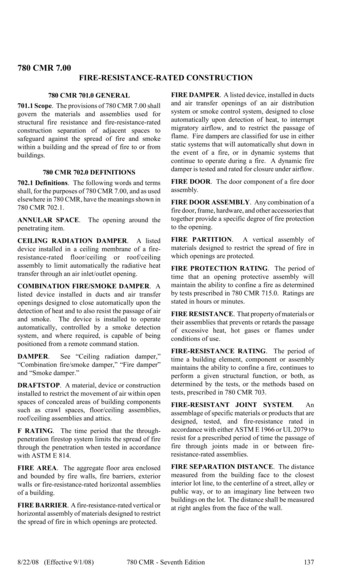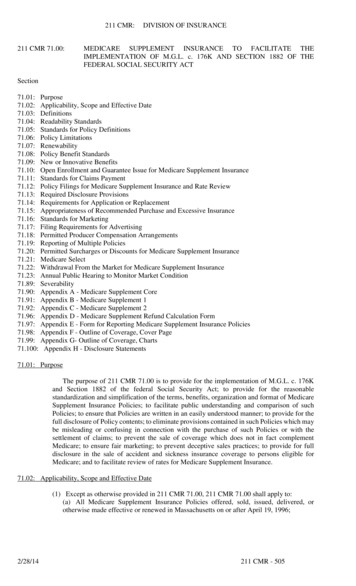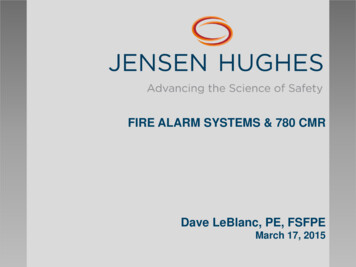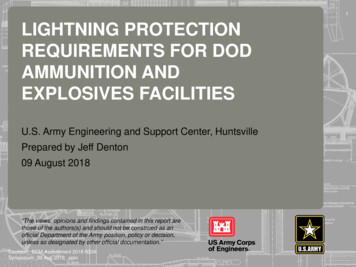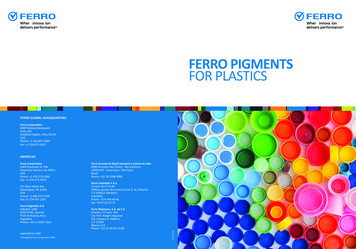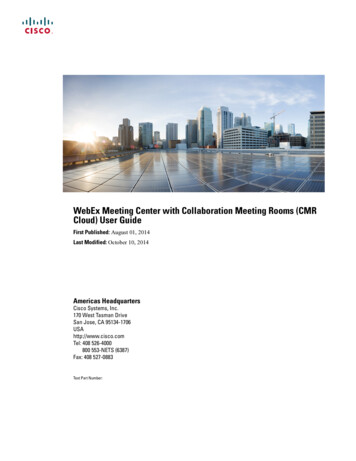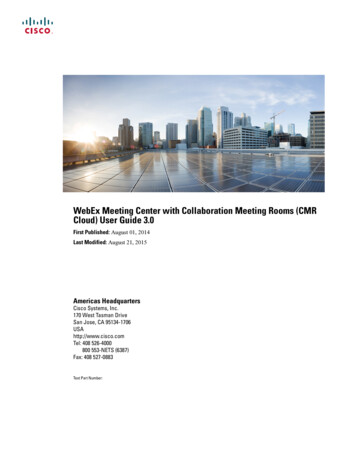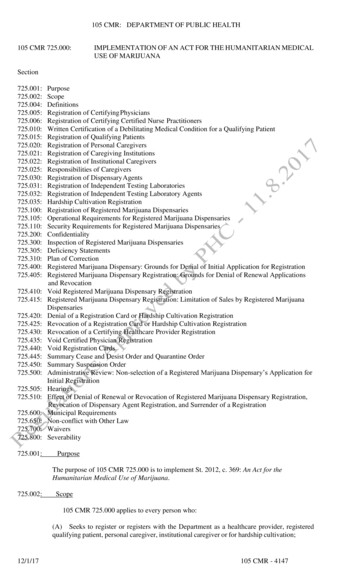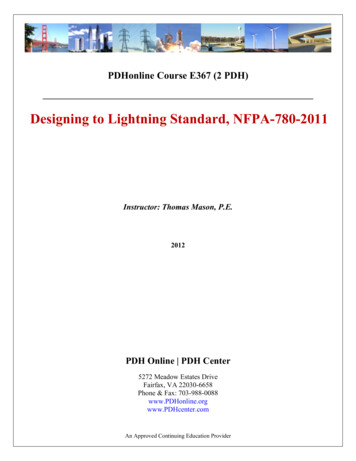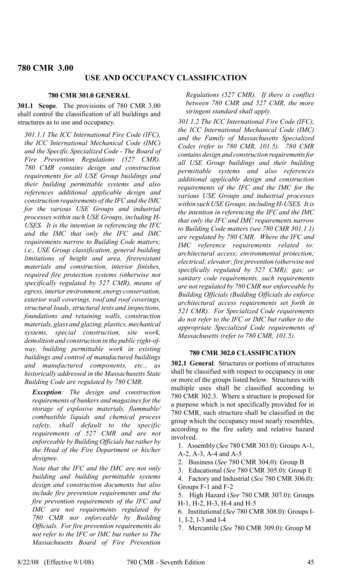
Transcription
780 CMR 3.00USE AND OCCUPANCY CLASSIFICATION780 CMR 301.0 GENERAL301.1 Scope. The provisions of 780 CMR 3.00shall control the classification of all buildings andstructures as to use and occupancy.301.1.1 The ICC International Fire Code (IFC),the ICC International Mechanical Code (IMC)and the Specific Specialized Code - The Board ofFire Prevention Regulations (527 CMR).780 CMR contains design and constructionrequirements for all USE Group buildings andtheir building permittable systems and alsoreferences additional applicable design andconstruction requirements of the IFC and the IMCfor the various USE Groups and industrialprocesses within such USE Groups, including HUSES. It is the intention in referencing the IFCand the IMC that only the IFC and IMCrequirements narrow to Building Code matters;i.e., USE Group classification, general buildinglimitations of height and area, fireresistantmaterials and construction, interior finishes,required fire protection systems (otherwise notspecifically regulated by 527 CMR), means ofegress, interior environment, energy conservation,exterior wall coverings, roof and roof coverings,structural loads, structural tests and inspections,foundations and retaining walls, constructionmaterials, glass and glazing, plastics, mechanicalsystems, special construction, site work,demolition and construction in the public right-ofway, building permittable work in existingbuildings and control of manufactured buildingsand manufactured components, etc., ashistorically addressed in the Massachusetts StateBuilding Code are regulated by 780 CMR.Exception: The design and constructionrequirements of bunkers and magazines for thestorage of explosive materials, flammable/combustible liquids and chemical processsafety, shall default to the specificrequirements of 527 CMR and are notenforceable by Building Officials but rather bythe Head of the Fire Department or his/herdesignee.Note that the IFC and the IMC are not onlybuilding and building permittable systemsdesign and construction documents but alsoinclude fire prevention requirements and thefire prevention requirements of the IFC andIMC are not requirements regulated by780 CMR nor enforceable by BuildingOfficials. For fire prevention requirements donot refer to the IFC or IMC but rather to TheMassachusetts Board of Fire Prevention8/22/08 (Effective 9/1/08)Regulations (527 CMR). If there is conflictbetween 780 CMR and 527 CMR, the morestringent standard shall apply.301.1.2 The ICC International Fire Code (IFC),the ICC International Mechanical Code (IMC)and the Family of Massachusetts SpecializedCodes (refer to 780 CMR, 101.5). 780 CMRcontains design and construction requirements forall USE Group buildings and their buildingpermittable systems and also referencesadditional applicable design and constructionrequirements of the IFC and the IMC for thevarious USE Groups and industrial processeswithin such USE Groups, including H-USES. It isthe intention in referencing the IFC and the IMCthat only the IFC and IMC requirements narrowto Building Code matters (see 780 CMR 301.1.1)are regulated by 780 CMR. Where the IFC andIMC reference requirements related to:architectural access; environmental protection;electrical; elevator; fire prevention (otherwise notspecifically regulated by 527 CMR); gas; orsanitary code requirements, such requirementsare not regulated by 780 CMR nor enforceable byBuilding Officials (Building Officials do enforcearchitectural access requirements set forth in521 CMR). For Specialized Code requirementsdo not refer to the IFC or IMC but rather to theappropriate Specialized Code requirements ofMassachusetts (refer to 780 CMR, 101.5).780 CMR 302.0 CLASSIFICATION302.1 General. Structures or portions of structuresshall be classified with respect to occupancy in oneor more of the groups listed below. Structures withmultiple uses shall be classified according to780 CMR 302.3. Where a structure is proposed fora purpose which is not specifically provided for in780 CMR, such structure shall be classified in thegroup which the occupancy most nearly resembles,according to the fire safety and relative hazardinvolved.1. Assembly (See 780 CMR 303.0): Groups A-1,A-2, A-3, A-4 and A-52. Business (See 780 CMR 304.0): Group B3. Educational (See 780 CMR 305.0): Group E4. Factory and Industrial (See 780 CMR 306.0):Groups F-1 and F-25. High Hazard (See 780 CMR 307.0): GroupsH-1, H-2, H-3, H-4 and H-56. Institutional (See 780 CMR 308.0): Groups I1, I-2, I-3 and I-47. Mercantile (See 780 CMR 309.0): Group M780 CMR - Seventh Edition45
780 CMR: STATE BOARD OF BUILDING REGULATIONS AND STANDARDSTHE MASSACHUSETTS STATE BUILDING CODE8. Residential (See 780 CMR 310.0): Groups R1, R-2, R-3 as applicable in 780 CMR 101.2, andR-49. Storage (See 780 CMR 311.0): Groups S-1and S-210. Utility and Miscellaneous (See 780 CMR312.0): Group U302.1.1 Incidental Use Areas. Spaces which areincidental to the main occupancy shall beseparated or protected, or both, in accordance withTable 302.1.1 or the building shall be classified asa mixed occupancy and comply with 780 CMR302.3. Areas that are incidental to the mainoccupancy shall be classified in accordance withthe main occupancy of the portion of the buildingin which the incidental use area is located.Exception: Incidental use areas within andserving a dwelling unit are not required tocomply with 780 CMR 302.0.302.1.1.1 Separation. Where Table 302.1.1requires a fire-resistance-rated separation, theincidental use area shall be separated from theremainder of the building with a fire barrier.Where Table 302.1.1 permits an automatic fireextinguishing system without a fire barrier, theincidental use area shall be separated byconstruction capable of resisting the passage ofsmoke. The partitions shall extend from thefloor to the underside of the fire-resistancerated floor/ceiling assembly or fire-resistancerated roof/ceiling assembly or to the undersideof the floor or roof deck above. Doors shall beself-closing or automatic-closing upondetection of smoke. Doors shall not have airtransfer openings and shall not be undercut inexcess of the clearance permitted in accordancewith NFPA 80.TABLE 302.1.1INCIDENTAL USE AREASROOM OR AREAFurnace room where any pieceof equipment is over 400,000Btu per hour inputRooms with any boiler over 15psi and 10 horsepowerSEPARATION a1 hour or provide automaticfire-extinguishing system1 hour or provide automaticfire-extinguishing system1 hour or provide automaticRefrigerant machinery roomssprinkler system2 hours; or 1 hour andParking garage (Section 406.2) p r o v id e auto matic fire extinguishing systemHydrogen cut-off rooms1 -h o u r fire b a r r ie r s a n dfloor/ceiling assemblies inGroup B, F, H, M , S and Uoccupancies. 2-hour firebarriers and floor/ceilingassemblies in Group A, E, Iand R occupancies.Incinerator rooms2 h o u rs a n d a u to m a t i csprinkler systemPaint shops, not classified as 2 hours; or 1 hour andG ro up H , located in p r o v i d eautomaticoccupancies other than Group fire-extinguishing systemFLaboratories and vocationalshops, not classified as GroupH, located in Group E or I-2occupanciesLaundry rooms over 100 squarefeetStorage rooms over 100 squarefeetGroup I-3 cells equipped withpadded surfacesGroup I-2 waste and linencollection roomsW aste and linen collectionrooms over 100 square feetStationary lead-acid batterysystem s having a liquidcapacity of more than 100gallons used for facilitystandby power, emergencypower or uninterrupted powersupplies1 hour or provide automaticfire-extinguishing system1 hour or provide automaticfire-extinguishing system1 hour or provide automaticfire-extinguishing system1 hour1 hour1 hour or provide automaticfire-extinguishing system1-hour fire barriers andfloor/ceiling assemblies inGroup B, F, H , M, S and Uoccupancies. 2-hour firebarriers and floor/ceilingassemblies in Group A, E, Iand R occupanciesFor SI: 1 square foot 0.0929 m2, 1 pound persquare inch 6.9 kPa, 1 British thermal unit perhour 0.293 watts, 1 horsepower 746 watts, 1gallon 3.785 L.a. Where an automatic fire-extinguishing system isprovided, it need only be provided in the incidentaluse room or area302.2 Accessory Use Areas. A fire barrier shall berequired to separate accessory use areas classified asGroup H in accordance with 780 CMR 302.3.2, andincidental use areas in accordance with 780 CMR302.1.1. Any other accessory use area shall not berequired to be separated by a fire barrier provided theaccessory use area occupies an area not more than10% of the area of the story in which it is locatedand does not exceed the tabular values in Table 503for the allowable height or area for such use.46780 CMR - Seventh Edition8/22/08 (Effective 9/1/08)
780 CMR: STATE BOARD OF BUILDING REGULATIONS AND STANDARDSUSE AND OCCUPANCY CLASSIFICATION302.2.1 Assembly Areas. Accessory assemblyareas are not considered separate occupancies ifthe floor area is equal to or less than 750 squarefeet (69.7 m2). Assembly areas that are accessoryto Group E are not considered separateoccupancies. Accessory religious educationalrooms and religious auditoriums with occupantloads of less than 100 are not considered separateoccupancies (also See 780 CMR 303.1 and303.1.1).302.3 Mixed Occupancies. Where a building isoccupied by two or more uses not included in thesame occupancy classification, the building orportion thereof shall comply with 780 CMR 302.3.1and/or 302.3.2.Exceptions:1. Occupancies separated in accordance with780 CMR 508.0.2.Areas of Group H-2, H-3, H-4 or H-5occupancies shall be separated from any otheroccupancy in accordance with 780 CMR 302.3.2.3. Where required by Table 415.3.2, areas ofGroup H-1, H-2 or H-3 occupancy shall be locatedin a separate and detached building or structure.4.Accessory use areas in accordance with780 CMR 302.2.5.Incidental use areas in accordance with780 CMR 302.1.1.302.3.1 Nonseparated Uses. Each portion of thebuilding shall be individually classified as to use.The required type of construction for the buildingshall be determined by applying the height andarea limitations for each of the applicableoccupancies to the entire building. The mostrestrictive type of construction, so determined,shall apply to the entire building. All other coderequirements shall apply to each portion of thebuilding based on the use of that space except that8/22/08 (Effective 9/1/08)the most restrictive applicable provisions of780 CMR 403.0 and 780 CMR 9.00 shall apply tothese nonseparated uses. Fire separations are notrequired between uses, except as required by otherprovisions.302.3.2 Separated Uses. Each portion of thebuilding shall be individually classified as to useand shall be completely separated from adjacentareas by fire barrier walls or horizontal assembliesor both having a fire-resistance rating determinedin accordance with Table 302.3.2 for uses beingseparated. Each fire area shall comply with780 CMR based on the use of that space. Eachfire area shall comply with the height limitationsbased on the use of that space and the type ofconstruction classification. In each story, thebuilding area shall be such that the sum of theratios of the floor area of each use divided by theallowable area for each use shall not exceed one.Exception: Except for Group H and I-2 areas,where the building is equipped throughout withan automatic sprinkler system, installed inaccordance with 780 CMR 903.3.1.1, the fireresistance ratings in Table 302.3.3 shall bereduced by one hour but to not less than 1 hourand to not less than that required for floorconstruction according to the type ofconstruction.302.4 Spaces Used for Different Purposes. Aroom or space that is intended to be occupied atdifferent times for different purposes shall complywith all the requirements that are applicable to eachof the purposes for which the room or space will beoccupied.780 CMR - Seventh Edition47
780 CMR: STATE BOARD OF BUILDING REGULATIONS AND STANDARDSTHE MASSACHUSETTS STATE BUILDING CODETABLE 302.3.2 REQUIRED SEPARATIONOF OCCUPANCIES (HOURS)48780 CMR - Seventh Edition8/22/08 (Effective 9/1/08)
780 CMR: STATE BOARD OF BUILDING REGULATIONS AND STANDARDSUSE AND OCCUPANCY CLASSIFICATION780 CMR 303.0 ASSEMBLY GROUP A303.1 Assembly Group A. Assembly Group Aoccupancy includes, among others, the use of abuilding or structure, or a portion thereof, for thegathering together of persons for purposes such ascivic, social or religious functions, recreation, foodor drink consumption or awaiting transportation. Aroom or space used for assembly purposes by lessthan 50 persons and accessory to another occupancyshall be included as a part of that occupancy.Assembly areas with less than 750 square feet (69.7m2) and which are accessory to another occupancyaccording to 780 CMR 302.2.1 are not assemblyoccupancies. Assembly occupancies which areaccessory to Group E in accordance with 780 CMR302.2 are not considered assembly occupancies.Religious educational rooms and religiousauditoriums which are accessory to churches inaccordance with 780 CMR 302.2 and which haveoccupant loads of less than 100 shall be classified asA-3.Assembly occupancies shall include the following:(1)A-1 Assembly uses, usually with fixedseating, intended for the production and viewingof the performing arts or motion picturesincluding, but not limited to:(a) Motion picture theaters(b) Symphony and concert halls(c) Television and radio studios admitting anaudience(d) Theaters(2) A-2 Assembly uses intended for food and/ordrink consumption shall be further categorizedas A-2r and A-2nc (where A-2nc is the AssemblyUSE designation narrow to night clubs and A-2ris the USE designation for A-2 USES other thannight clubs); A-2 USES include but are notlimited to:(a) Banquet halls(b) Night clubs(c) Restaurants(d) Taverns and barsNote: independent of the “A-2” USEClassification set forth in 780 CMR303.1(2), requirements associated withM.G.L. c. 148, § 26G.5, M.G.L. c. 148A,M.G.L. c. 143, § 97A – all such GeneralLaws related to St. 2004, c. 304 - couldultimately result in an A-2r USE beingreclassified as an A-2nc USE.(3) A-3 Assembly uses intended for worship,recreation or amusement and other assembly usesnot classified elsewhere in Group A including, butnot limited to:(a) Amusement arcades(b) Art galleries(c) Bowling alleys(d) Churches(e) Community halls(f) Courtrooms8/22/08 (Effective 9/1/08)(g) Dance halls (not including food or drinkconsumption)(h) Exhibition halls(i) Funeral parlors(j) Gymnasiums (without spectator seating)(k) Indoor swimming pools (without spectatorseating)(l) Indoor tennis courts (without spectatorseating)(m) Lecture halls(n) Libraries(o) Museums(p) Waiting areas in transportation terminals(q) Pool and billiard parlors(4) A-4 Assembly uses intended for viewing ofindoor sporting events and activities withspectator seating including, but not limited to:(a) Arenas(b) Skating rinks(c) Swimming pools(d) Tennis courts(5) A-5 Assembly uses intended for participationin or viewing outdoor activities including, but notlimited to:(a) Amusement park structures(b) Bleachers(c) Grandstands(d) Stadiums303.1.1 Nonaccessory Assembly Use.Abuilding or tenant space used for assemblypurposes by less than 50 persons shall beconsidered a Group B occupancy.780 CMR 304.0 BUSINESS GROUP B304.1 Business Group B. Business Group Boccupancy includes, among others, the use of abuilding or structure, or a portion thereof, for office,professional or service-type transactions, includingstorage of records and accounts.Businessoccupancies shall include, but not be limited to, thefollowing:(1) Airport traffic control towers(2) Animal hospitals, kennels and pounds(3) Banks(4) Barber and beauty shops(5) Car wash(6) Civic administration(7) Clinic—outpatient(8) Dry cleaning and laundries; pick-up anddelivery stations and self-service(9) Educational occupancies above the 12thgrade(10) Electronic data processing(11) Laboratories; testing and research(12) Motor vehicle showrooms(13) Post offices(14) Print shops(15) Professional services (architects, attorneys,dentists, physicians, engineers, etc.)780 CMR - Seventh Edition49
780 CMR: STATE BOARD OF BUILDING REGULATIONS AND STANDARDSTHE MASSACHUSETTS STATE BUILDING CODE(16) Radio and television stations(17) Telephone exchanges780 CMR 305.0 EDUCATIONAL GROUP E305.1 Educational Group E. Educational Group Eoccupancy includes, among others, the use of abuilding or structure, or a portion thereof, by six ormore persons at any one time for educationalpurposes through the 12th grade.Religiouseducational rooms and religious auditoriums, whichare accessory to churches in accordance with780 CMR 302.2 and have occupant loads of lessthan 100, shall be classified as A-3 occupancies.305.2 Day Care.In conjunction with theadditional applicable requirements of 780 CMR,422, the use of a building or structure, or portionthereof, for educational, supervision or personalcare services for children older than two years andnine months years of age, shall be classified as aGroup E occupancy (also see 780 CMR 308.5) –Note however, that the express Special Use andOccupancy requirements of 780 CMR 422.0, forDay care occupancies shall override the generalrequirements and limitations of E and I USE.780 CMR 306.0 FACTORY GROUP F306.1 Factory Industrial Group F. FactoryIndustrial Group F occupancy includes, amongothers, the use of a building or structure, or a portionthereof, for assembling, disassembling, fabricating,finishing, manufacturing, packaging, repair orprocessing operations that are not classified as aGroup H hazardous or Group S storage occupancy.306.2 Factory Industrial F-1 Moderate-HazardOccupancy. Factory industrial uses which are notclassified as Factory Industrial F-2 Low Hazard shallbe classified as F-1 Moderate Hazard and shallinclude, but not be limited to, the following:(1) Aircraft(2) Appliances(3) Athletic equipment(4) Automobiles and other motor vehicles(5) Bakeries(6) Beverages; over 12% alcohol content(7) Bicycles(8) Boats(9) Brooms or brushes(10) Business machines(11) Cameras and photo equipment(12) Canvas or similar fabric(13) Carpets and rugs (includes cleaning)(14) Clothing(15) Construction and agricultural machinery(16) Disinfectants(17) Dry cleaning and dyeing(18) Electric generation plants(19) Electronics(20) Engines (including rebuilding)(21) Food processing50(22) Furniture(23) Hemp products(24) Jute products(25) Laundries(26) Leather products(27) Machinery(28) Metals(29) Millwork (sash & door)(30) Motion pictures and television filming(without spectators)(31) Musical instruments(32) Optical goods(33) Paper mills or products(34) Photographic film(35) Plastic products(36) Printing or publishing(37) Recreational vehicles(38) Refuse incineration(39) Shoes(40) Soaps and detergents(41) Textiles(42) Tobacco(43) Trailers(44) Upholstering(45) Wood; distillation(46) Woodworking (cabinet)306.3 Factory Industrial F-2 Low-HazardOccupancy. Factory industrial uses that involve thefabrication or manufacturing of noncombustiblematerials which during finishing, packing orprocessing do not involve a significant fire hazardshall be classified as F-2 occupancies and shallinclude, but not be limited to, the following:(1) Beverages; up to and including 12% alcoholcontent(2) Brick and masonry(3) Ceramic products(4) Foundries(5) Glass products(6) Gypsum(7) Ice(8) Metal products (fabrication and assembly)780 CMR 307.0 HIGH-HAZARD GROUP H[F] 307.1 High-Hazard Group H. High-HazardGroup H occupancy includes, among others, the useof a building or structure, or a portion thereof, thatinvolves the manufacturing, processing, generationor storage of materials that constitute a physical orhealth hazard in quantities in excess of those foundin Tables 307.7(1) and 307.7(2) (See also definitionof “Control area”).[F] 307.2 Definitions. The following words andterms shall, for the purposes of 780 CMR 307.0 andas used elsewhere in 780 CMR, have the meaningsshown in 780 CMR 307.2.AEROSOL. A product that is dispensed from anaerosol container by a propellant.780 CMR - Seventh Edition8/22/08 (Effective 9/1/08)
780 CMR: STATE BOARD OF BUILDING REGULATIONS AND STANDARDSUSE AND OCCUPANCY CLASSIFICATIONAerosol products shall be classified by means ofthe calculation of their chemical heats of combustionand shall be designated Level 1, 2 or 3.Level 1 Aerosol Products. Those with a totalchemical heat of combustion that is less than orequal to 8,600 British thermal units per pound(Btu/lb) (20 kJ/g).Level 2 Aerosol Products. Those with a totalchemical heat of combustion that is greater than8,600 Btu/lb (20 kJ/g), but less than or equal to13,000 Btu/lb (30 kJ/g).Level 3 Aerosol Products. Those with a totalchemical heat combustion that is greater than13,000 Btu/lb (30 kJ/g).AEROSOL CONTAINER. A metal can or a glassor plastic bottle designed to dispense an aerosol.Metal cans shall be limited to a maximum size of33.8 fluid ounces (1,000 ml). Glass or plastic bottlesshall be limited to a maximum size of 4 fluid ounces(118 ml).BARRICADE. A structure that consists of acombination of walls, floor and roof, which isdesigned to withstand the rapid release of energy inan explosion and which is fully confined, partiallyvented or fully vented; or other effective method ofshielding from explosive materials by a natural orartificial barrier.Artificial Barricade. An artificial mound orrevetment a minimum thickness of 3 feet (914mm).Natural Barricade. Natural features of theground, such as hills, or timber of sufficientdensity that the surrounding exposures that requireprotection cannot be seen from the magazine orbuilding containing explosives when the trees arebare of leaves.BOILING POINT. The temperature at which thevapor pressure of a liquid equals the atmosphericpressure of 14.7 pounds per square inch (psi) (101kPa) gage or 760 mm of mercury. Where anaccurate boiling point is unavailable for the materialin question, or for mixtures which do not have a8/22/08 (Effective 9/1/08)constant boiling point, for the purposes of thisclassification, the 20% evaporated point of adistillation performed in accordance with ASTM D86 shall be used as the boiling point of the liquid.CLOSED SYSTEM. The use of a solid or liquidhazardous material involving a closed vessel orsystem that remains closed during normal operationswhere vapors emitted by the product are notliberated outside of the vessel or system and theproduct is not exposed to the atmosphere duringnormal operations; and all uses of compressed gases.Examples of closed systems for solids and liquidsinclude product conveyed through a piping systeminto a closed vessel, system or piece of equipment.COMBUSTIBLE DUST. Finely divided solidmaterial that is 420 microns or less in diameter andwhich, when dispersed in air in the properproportions, could be ignited by a flame, spark orother source of ignition. Combustible dust will passthrough a U.S. No. 40 standard sieve.COMBUSTIBLE FIBERS. Readily ignitable andfree-burning fibers, such as cocoa fiber, cloth,cotton, excelsior, hay, hemp, henequen, istle, jute,kapok, oakum, rags, sisal, Spanish moss, straw, tow,wastepaper, certain synthetic fibers or other likematerials.COMBUSTIBLE LIQUID. A liquid having aclosed cup flash point at or above 100 F (38 C).Combustible liquids shall be subdivided as follows:Class II. Liquids having a closed cup flash pointat or above 100 F (38 C) and below 140 F(60 C).Class IIIA. Liquids having a closed cup flashpoint at or above 140 F (60 C) and below 200 F(93 C).Class IIIB. Liquids having a closed cup flashpoint at or above 200 F (93 C).The category of combustible liquids does not includecompressed gases or cryogenic fluids.780 CMR - Seventh Edition51
780 CMR: STATE BOARD OF BUILDING REGULATIONS AND STANDARDSTHE MASSACHUSETTS STATE BUILDING CODETABLE 307.7(1) MAXIMUM ALLOWABLEQUANTITY PER CONTROL AREA OFHAZARDOUS MATERIALS POSINGA PHYSICAL HAZARD52780 CMR - Seventh Edition8/22/08 (Effective 9/1/08)
780 CMR: STATE BOARD OF BUILDING REGULATIONS AND STANDARDSUSE AND OCCUPANCY CLASSIFICATION8/22/08 (Effective 9/1/08)780 CMR - Seventh Edition53
780 CMR: STATE BOARD OF BUILDING REGULATIONS AND STANDARDSTHE MASSACHUSETTS STATE BUILDING CODETABLE 307.7(2) MAXIMUM ALLOWABLE QUANTITY PER CONTROL AREA OFHAZARDOUS MATERIALS POSING A HEALTH HAZARDa, b, c, jSTORAGE dM ATERIALCorrosiveHighly toxicToxicSolidpoundse,fUSE-CLOSED SYSTEM S dLiquidgallons Gas (cubic feetat NTP) e(pounds)e,f5000500810f,10(10) i20 h500(500)i810gSolidpoundseLiquid gallons Gas (cubic feet(pounds) eat NTP) e5000500810f,10(10) i20 hf500USE-OPEN SYSTEM S d(500)i810gfSolidpoundseLiquid gallons(pounds) e10001003(3) i125(125)i3For SI: 1 cubic foot 0.028 m , 1 pound 0.454 kg, 1 gallon 3.785 L.a. For use of control areas, see 780 CMR 414.2.b. In retail and wholesale sales occupancies, the quantities of medicines, foodstuffs, consumer or industrialproducts, and cosmetics, containing not more than 50% by volume of water-miscible liquids and with theremainder of the solutions not being flammable, shall not be limited, provided that such materials arepackaged in individual containers not exceeding 1.3 gallons.c. For storage and display quantities in Group M and storage quantities in Group S occupancies complyingwith 780 CMR 414.2.4, see Table 414.2.4.d. The aggregate quantity in use and storage shall not exceed the quantity listed for storage.e. Quantities shall be increased 100%t in buildings equipped throughout with an approved automatic sprinklersystem in accordance with 780CMR 903 .3.1.1. Where Note f also applies, the increase for both notes shallbe applied accumulatively.f. Quantities shall be increased 100% when stored in approved storage cabinets, gas cabinets or exhaustedenclosures as specified in the International Fire Code. Where Note e also applies, the increase for bothnotes shall be applied accumulatively.g. A single cylinder containing 150 pounds or less of anhydrous ammonia in a single control area in anonsprinklered building shall be considered a maximum allow able quantity. Two cylinders, eachcontaining 150 pounds or less in a single control area, shall be considered a maximum allowable quantityprovided the building is equipped throughout with an automatic sprinkler system in accordance with780 CMR 903.3.1.1.h. Allowed only when stored in approved exhausted gas cabinets or exhausted enclosures as specified in theInternational Fire Code.i. Quantities in parenthesis indicate quantity units in parenthesis at the head of each column.j. For gallons of liquids, divide the amount in pounds by ten in accordance with Section 2703.1.2 of theInternational Fire Code.COMPRESSED GAS. A material, or mixture ofmaterials which:1. Is a gas at 68 F (20 C) or less at 14.7 poundsper square inch atmosphere (psia) (101 kPa) ofpressure; and2. Has a boiling point of 68 F (20 C) or less at14.7 psia (101 kPa) which is either liquefied,nonliquefied or in solution, except those gaseswhich have no other health- or physical-hazardproperties are not considered to be compresseduntil the pressure in the packaging exceeds 41 psia(282 kPa) at 68 F (20 C).The states of a compressed gas are categorized asfollows:3. Nonliquefied compressed gases are gases,other than those in solution, which are in apackaging under the charged pressure and areentirely gaseous at a temperature of 68 F (20 C).4. Liquefied compressed gases are gases that, ina packaging under the charged pressure, arepartially liquid at a temperature of 68F (20 C).5. Compressed gases in solution are nonliquefiedgases that are dissolved in a solvent.4. Compressed gas mixtures consist of a mixtureof two or more compressed gases contained in a54packaging, the hazard properties of which arerepresented by the properties of the mixture as awhole.CONTROL AREA. Spaces within a building thatare enclosed and bounded by exterior walls, firewalls, fire barriers and roofs, or a combinationthereof, where quantities of hazardous materials notexceeding the maximum allowable quantities percontrol area are stored, dispensed, used or handled.CORROSIVE. A chemical that causes visibledestruction of, or irreversible alterations in, livingtissue by chemical action at the point of contact. Achemical shall be considered corrosive if, whentested on the intact skin of albino rabbits by themethod described in DOTn 49 CFR, Part 173.137,such a chemical destroys or changes irreversibly thestructure of the tissue at the point of contactfollowing an exposure period of 4 hours. This termdoes not refer to action on inanimate surfaces.CRYOGENIC FLUID. A liquid having a boilingpoint lower than -150 F (-101 C) at 14.7 pounds persquare inch atmosphere (psia) (an absolute pressureof 101 kPa).780 CMR - Seventh Edition8/22/08 (Effective 9/1/08)
780 CMR: STATE BOARD OF BUILDING REGULATIONS AND STANDARDSUSE AND OCCUPANCY CLASSIFICATIONDEFLAGRATION. An exothermic reaction, suchas the extremely rapid oxidation of a flammable dustor vapor in air, in which the reaction progressesthrough the unburned material at a rate less than thevelocity of sound. A deflagration can have anexplosive effect.DETACHED BUILDING. A separate single-storybuilding, without a basement or crawl space, usedfor the storage or use of hazardous materials andlocated an approved distance from all structures.DETONATION.An exothermic reactioncharacterized by the presence of a shock wave in thematerial which establishes and maintains thereaction. The reaction zone progresses through thematerial at a rate greater than the velocity of sound.The principal heating mechanism is one of shockcompression. Detonations have an explosive effect.DISPENSING. The pouring or transferring of anymaterial from a container, tank or similar vessel,whereby vapors, dusts, fumes, mists or gases areliberated to the atmosphere.EXPLOSIVE. Any chemical compound, mixture ordevice, the primary or common purpose of which isto function by explosion. The term includes, but isnot limited to,
occupa ncy in acc ordanc e with 780 CMR 302.3.2. 3. Where required by Table 415.3.2, areas of Group H- 1, H-2 or H -3 occ upancy shall be loca ted in a separate and detached building or structure. 4. Accessory use areas in accordance with 780 CMR 302.2. 5. Incidental use areas in accordance with 780 CMR 302.1.1. 302.3.1 Nonseparated Use s. Each .
